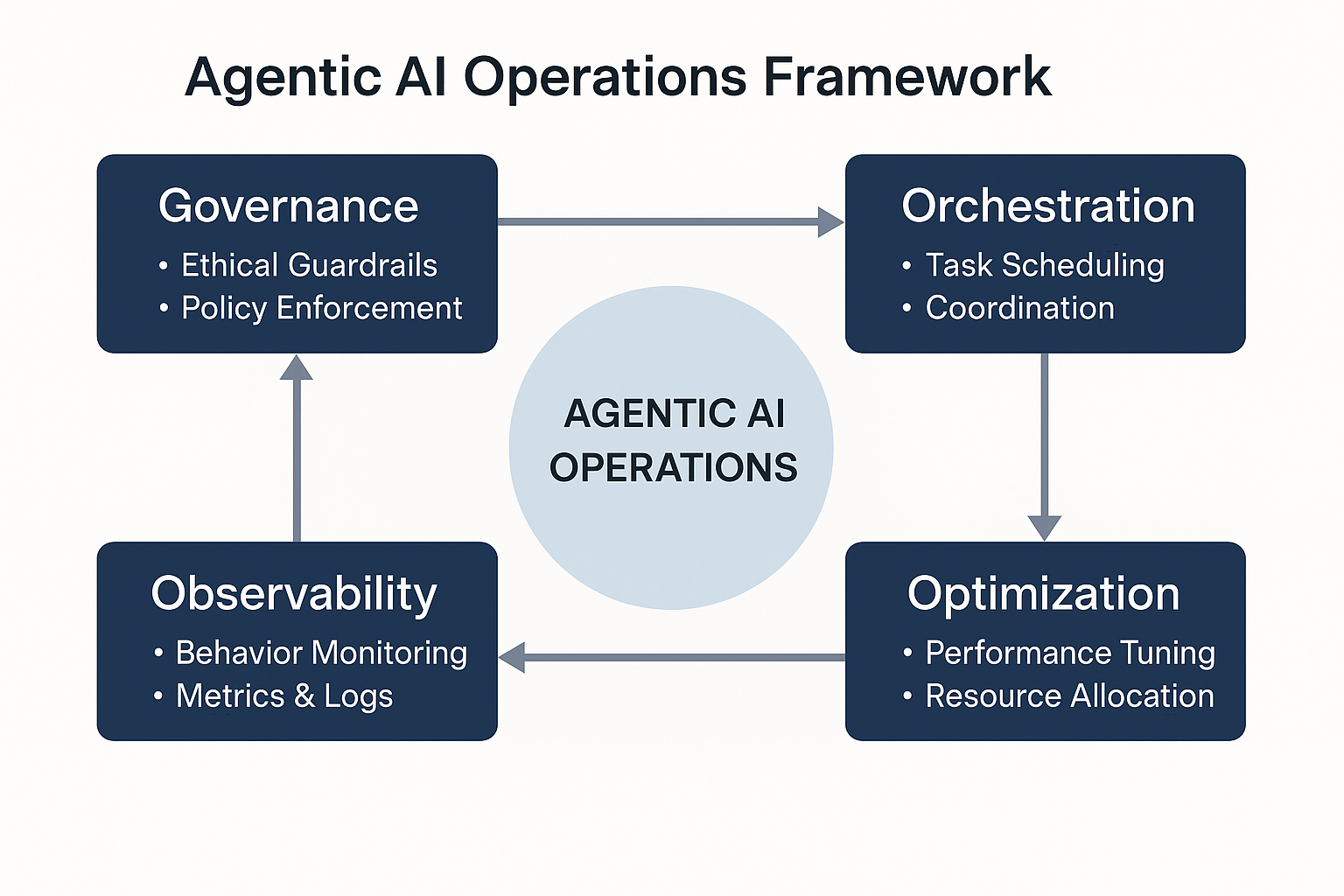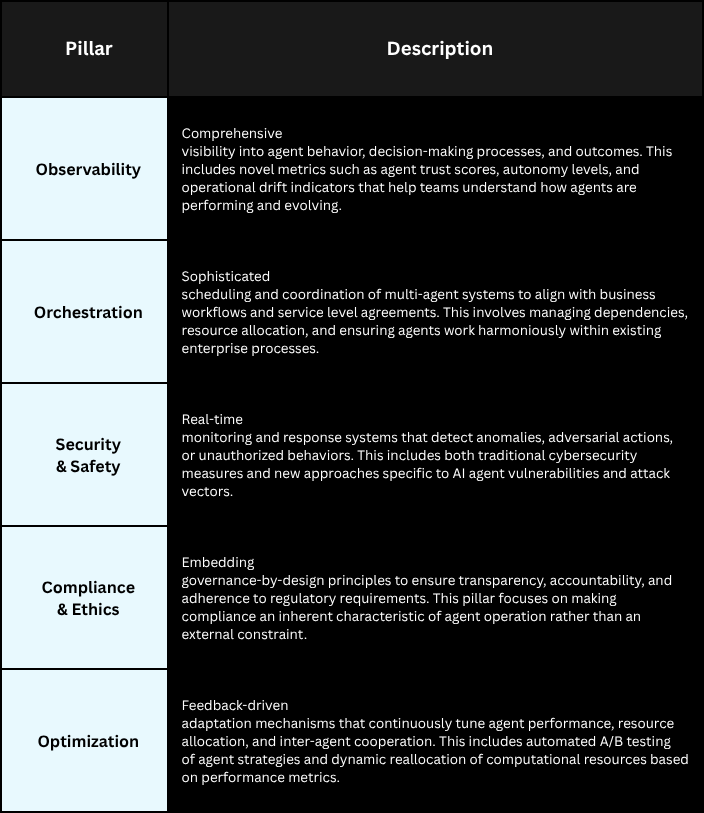Agentic AI Operations: The Next Frontier in Enterprise Automation
Enterprise AI is going through a dramatic transformation. What began as cautious experimentation with machine learning models has evolved into the bold deployment of autonomous AI agents capable of reasoning, decision-making, and acting independently. Yet as organizations embrace this new concept, a critical challenge emerges: how do you effectively manage, monitor, and govern AI systems that operate with varying degrees of autonomy? The answer lies in Agentic AI Operations (AIOps), a discipline that is rapidly becoming the cornerstone of successful AI-driven enterprises.
From AI Adoption to AI Operations
Enterprise AI adoption has progressed through distinct phases. Early adopters focused on proof-of-concept projects and isolated ML models. Organizations then moved to production deployments with traditional MLOps practices, managing model training, deployment, and monitoring. Today, we are witnessing the rapid adoption of agentic AI systems where autonomous agents collaborate, learn, and adapt in real-time.
This evolution mirrors the trajectory we've seen in software development: from traditional operations to DevOps, then to MLOps for machine learning systems. Now, we need AIOps specifically designed for agentic systems that possess agency, autonomy, and the ability to interact dynamically with both human users and other AI agents.
The stakes are higher with agentic AI. Unlike traditional models that provide predictions or classifications, autonomous agents make decisions and take actions that directly impact business operations. They can initiate transactions, communicate with customers, modify workflows, and even spawn new agent instances. This level of autonomy demands a new operational paradigm.
What is Agentic AI Operations?
Agentic AI Operations (AIOps) is the operational framework for managing multi-agent systems that learn, adapt, and act autonomously within enterprise environments. It encompasses the tools, processes, and governance structures needed to ensure these AI agents operate safely, effectively, and in alignment with organizational objectives.
The core functions of AIOps include:
Agent Lifecycle Management: This covers the complete journey from agent creation and deployment to ongoing monitoring and eventual retirement. Unlike traditional software, AI agents may evolve their capabilities, spawn child agents, or modify their own behavior based on learned experiences. Managing this dynamic lifecycle requires new approaches to versioning, rollback procedures, and dependency tracking.
Task Orchestration and Coordination: Modern enterprises deploy multiple AI agents that must work together seamlessly across organizations (internal and external) and systems. AIOps ensures proper coordination between human teams and digital workforce members, managing task delegation, priority queuing, and conflict resolution when agents have competing objectives.
Ethical and Operational Guardrails: Governance by design becomes critical when agents operate autonomously. This involves embedding ethical constraints, compliance requirements, and operational boundaries directly into agent architectures rather than relying solely on external oversight.
Agentic Feedback Loops: Continuous improvement mechanisms that allow agents to learn from their experiences while maintaining alignment with human values and business objectives. This includes sophisticated monitoring of agent behavior, outcome analysis, and adaptive refinement of agent capabilities.
AIOps intersects with emerging enterprise functions such as Agentic AI Governance, which focuses on policy and oversight, and Digital Workforce Management, which handles the integration of AI agents into human organizational structures.
The Core Pillars of Agentic AI Operations
Effective AIOps rests on five interconnected pillars:
Governance and Ethics by Design
Traditional AI governance often relies on after-the-fact oversight, auditing decisions and outcomes after they occur. Agentic AI demands a more proactive approach where governance is embedded into the very architecture of AI systems.
Two key approaches are emerging:
Governance by Design involves hard-coding guardrails directly into agent architectures. This includes ethical reasoning layers that agents consult before taking actions, policy APIs that provide real-time guidance on acceptable behaviors, and constraint networks that prevent agents from operating outside defined parameters. For example, a customer service agent might have built-in constraints preventing it from making commitments beyond certain financial thresholds or accessing sensitive customer data without proper authorization.
Decentralized Governance leverages blockchain technologies and decentralized autonomous organizations (DAOs) for federated control of cross-enterprise agents. This approach becomes particularly valuable when AI agents operate across organizational boundaries, such as in supply chain management or inter-company collaborations. Smart contracts can encode governance rules that multiple organizations agree upon, ensuring consistent behavior across different enterprise environments.
These approaches ensure operational trust and alignment with human intent while maintaining the autonomy that makes agentic AI valuable. The goal is not to constrain agents unnecessarily but to create frameworks where increased autonomy correlates with increased trustworthiness.
The Emerging Role of the Agentic AI Ops Team
Organizations are rapidly establishing new roles and teams dedicated to agentic AI operations. The Agentic AI Operations Engineer, Manager, and Centers of Excellence are becoming standard components of enterprise AI strategies.
Core responsibilities include:
Multi-Agent Environment Monitoring: Overseeing complex ecosystems where multiple agents interact, ensuring system stability and identifying potential points of failure or inefficiency. This requires new visualization tools and dashboards that can represent the dynamic relationships between agents and their collective impact on business processes.
Decision Auditing and Compliance Trails: Maintaining comprehensive records of agent decisions, the reasoning behind those decisions, and their outcomes. This creates accountability trails essential for regulatory compliance and organizational learning.
Version Management and Agent Lifecycle: Managing the deployment of new agent versions, coordinating retraining cycles, and orchestrating the retirement of outdated agents. This includes sophisticated rollback procedures and blue-green deployment strategies adapted for AI systems.
Cross-Functional Coordination: Serving as the bridge between AI Governance teams, Security operations, and Business Operations, ensuring that agentic AI initiatives align with broader organizational objectives and constraints.
The toolchain for AIOps teams includes integration with Model Context Protocol (MCP) for agent communication, AgentKit for agent development and deployment, LangGraph for workflow orchestration, and various specialized orchestration frameworks designed for multi-agent systems.
From Reactive to Autonomous Operations
Perhaps the most transformative aspect of AIOps is the shift toward self-healing AI systems. These systems can detect problems, diagnose root causes, and implement fixes with minimal human intervention.
Consider this example workflow: A compliance monitoring agent detects bias in the decisions made by a customer service agent. It automatically triggers a retraining task, while simultaneously alerting a governance review agent to examine recent decision logs. The governance agent conducts an automated audit, generates a compliance report, and routes it to human supervisors for approval. Upon human authorization, a deployment agent orchestrates the rollout of the retrained model with enhanced bias mitigation measures.
This level of autonomous operation redefines traditional concepts of system uptime and resilience. Instead of measuring time between failures, organizations begin tracking how quickly systems can self-diagnose and self-correct, creating more robust and adaptable operational environments.
The key to successful autonomous operations lies in designing proper escalation paths. Not every issue should be automatically resolved; some require human judgment or intervention. Effective AIOps systems know when to act autonomously and when to engage human operators.
Building a Foundation for Scalable Agentic Operations
Organizations embarking on their AIOps journey should follow a structured roadmap:
1. Establish an Agent Registry and Policy Engine: Create a centralized system that tracks all deployed agents, their capabilities, permissions, and current status. The policy engine should provide real-time guidance to agents about acceptable actions and behaviors within different contexts.
2. Deploy Monitoring and Observability Dashboards: Implement comprehensive monitoring that goes beyond traditional metrics to include agent-specific measures such as decision confidence levels, interaction patterns, and alignment scores with organizational objectives.
3. Define Escalation Paths: Create clear protocols for when agents should escalate decisions to human operators or other agents. This includes defining thresholds for confidence levels, financial impact, and regulatory sensitivity.
4. Implement Sandboxed Testing Environments: Establish isolated environments where new agents or agent modifications can be tested safely without impacting production systems. These environments should closely mirror production conditions while providing complete isolation.
5. Develop an AgentOps Maturity Model: Create a framework for assessing and improving AIOps capabilities over time. This model should include metrics for automation levels, governance effectiveness, security posture, and business value delivery.
Each step builds upon the previous ones, creating a robust foundation that can evolve with the organization's growing sophistication in agentic AI deployment.
The Future of AI-Driven Enterprises
“Just as DevOps transformed software delivery, Agentic AI Ops will redefine how intelligence operates at scale.”
Agentic AI Operations will become the nerve center of the digital enterprise, serving as the critical bridge between AI ethics, traditional DevOps practices, and measurable business value. As organizations deploy increasingly sophisticated agent ecosystems, AIOps provides both the governance layer that ensures responsible AI deployment and the growth engine that enables scaling autonomous operations.
The future enterprise will be characterized by seamless collaboration between human and AI agents, with AIOps serving as the orchestrating layer that ensures this collaboration is productive, safe, and aligned with organizational values. Success will be measured not just by the sophistication of individual AI agents, but by the effectiveness of the operational systems that govern their collective behavior.
As agentic ecosystems grow in complexity and capability, AIOps becomes both the governance layer and the growth engine, ensuring that autonomy never outpaces accountability. Organizations that invest in robust AIOps capabilities today will be best positioned to leverage the transformative potential of agentic AI while maintaining the trust and control essential for sustainable business success.
The next frontier in enterprise automation is not just about building smarter AI agents; it's about creating the operational excellence that allows those agents to thrive in complex, dynamic business environments. Agentic AI Operations is the discipline that makes this future possible.


